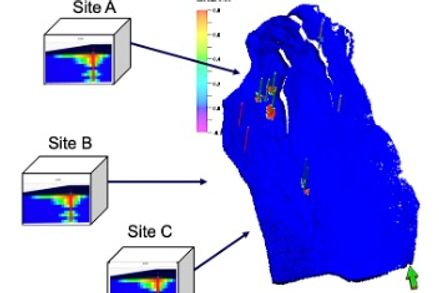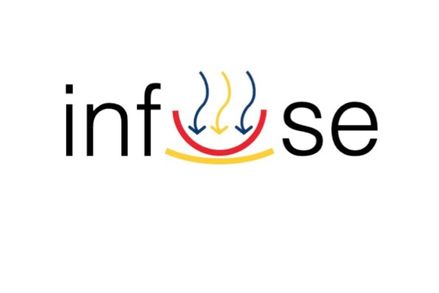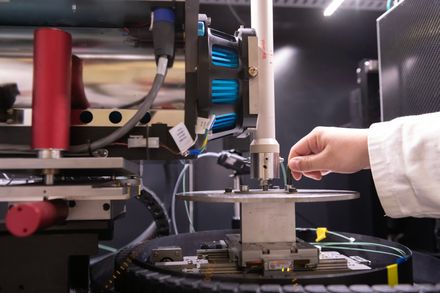We investigate the physics, chemistry, and techno-economics of CO2 storage underground
Our research includes exploring fundamental pore scale fluid dynamics, developing digital rocks analysis techniques, increasing the accuracy of field scale reservoir simulation, and evaluating the feasibility of scaling up CO2 storage to climate relevant scales.
Our Research Projects
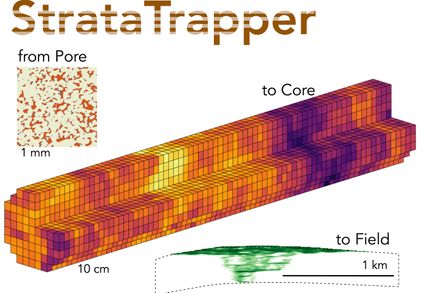
StrataTrapper Advanced Modelling of CO2 Migration and Trapping
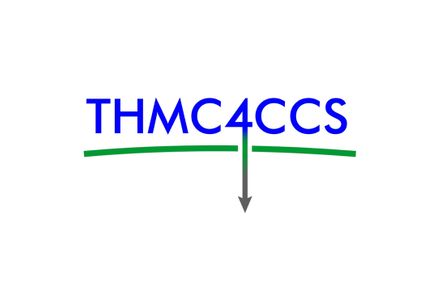
THMC4CCS: ThorougH experiMental and numerical investigation of Coupled processes for geologiC Carbon Storage
Results
- Showing results for:
- Reset all filters
Search results
-
Journal articleJackson S, Agada S, Reynolds C, et al., 2017,
Characterising Drainage Multiphase Flow in Heterogeneous Sandstones
<jats:p>In this work, we analyse the characterisation of drainage multiphase flow properties on heterogeneous rock cores using a rich experimental dataset and mm-m scale numerical simulations. Along with routine multiphase flow properties, 3D sub-metre scale capillary pressure heterogeneity is characterised by combining experimental observations and numerical calibration, resulting in a 3D numerical model of the rock core. The uniqueness and predictive capability of the numerical models are demonstrated by accurately predicting the experimentally measured relative permeability of N2-DI water and CO2-brine systems in two distinct sandstone rock cores across multiple fractional flow regimes and total flow rates. The numerical models are used to derive equivalent relative permeabilities, which are upscaled functions incorporating the effects of sub-metre scale capillary pressure. The functions are obtained across capillary numbers which span four orders of magnitude, representative of the range of flow regimes that occur in subsurface CO2 injection. Removal of experimental boundary artefacts allows the derivation of equivalent functions which are characteristic of the continuous subsurface. We also demonstrate how heterogeneities can be re-orientated and re-structured efficiently to obtain large amounts of information about expected flow regimes through different small-scale rock structures. This analysis shows how combined experimental and numerical characterisation of rock samples can be used to derive equivalent flow properties from heterogeneous rocks.</jats:p>
-
Journal articleKolster C, Masnadi MS, Krevor S, et al., 2017,
CO2 enhanced oil recovery: a catalyst for gigatonne-scale carbon capture and storage deployment?
, Energy and Environmental Science, Vol: 10, Pages: 2594-2608, ISSN: 1754-5692Using carbon dioxide for enhanced oil recovery (CO2-EOR) has been widely cited as a potential catalyst for gigatonne-scale carbon capture and storage (CCS) deployment. Carbon dioxide enhanced oil recovery could provide revenues for CO2 capture projects in the absence of strong carbon taxes, providing a means for technological learning and economies of scale to reduce the cost of CCS. We develop an open-source techno-economic Model of Iterative Investment in CCS with CO2-EOR (MIICE), using dynamic technology deployment modeling to assess the impact of CO2-EOR on the deployment of CCS. Synthetic sets of potential CCS with EOR projects are created with typical field characteristics and dynamic oil and CO2 production profiles. Investment decisions are made iteratively over a 35 year simulation period, and long-term changes to technology cost and revenues are tracked. Installed capacity at 2050 is used as an indicator, with 1 gigatonne per year of CO2 capture used as a benchmark for successful large-scale CCS deployment. Results show that current CO2 tax and oil price conditions do not incentivize gigatonne-scale investment in CCS. For current oil prices ($45 per bbl–$55 per bbl), the final CO2 tax must reach $70 per tCO2 for gigatonne-scale deployment. If oil price alone is expected to induce CCS deployment and learning, oil prices above $85 per bbl are required to promote the development of a gigatonne-scale CCS industry. Nonlinear feedbacks between early deployment and learning result in large changes in final state due to small changes in initial conditions. We investigate the future of CCS in five potential ‘states of the world’: an optimistic ‘Base Case’ with a low CO2 tax and low oil price, a ‘Climate Action’ world with high CO2 tax, a ‘High Oil’ world with high oil prices, a ‘Depleting Resources’ world with an increasing deficit in oil supply, and a ‘Forward Learning’ world where mechan
-
Journal articleKolster C, Agada S, Mac Dowell N, et al., 2017,
The impact of time-varying CO2 injection rate on large scale storage in the UK Bunter Sandstone
, International Journal of Greenhouse Gas Control, Vol: 68, Pages: 77-85, ISSN: 1750-5836Carbon capture and storage (CCS) is expected to play a key role in meeting targets set by the Paris Agreement and for meeting legally binding greenhouse gas emissions targets set within the UK (Energy and Climate Change Committee, 2016). Energy systems models have been essential in identifying the importance of CCS but they neglect to impose constraints on the availability and use of geologic CO2 storage reservoirs. In this work we analyse reservoir performance sensitivities to varying CO2 storage demand for three sets of injection scenarios designed to encompass the UK's future low carbon energy market. We use the ECLIPSE reservoir simulator and a model of part of the Southern North Sea Bunter Sandstone saline aquifer. From a first set of injection scenarios we find that varying amplitude and frequency of injection on a multi-year basis has little effect on reservoir pressure response and plume migration. Injectivity varies with site location due to variations in depth and regional permeability. In a second set of injection scenarios, we show that with envisioned UK storage demand levels for a large coal fired power plant, it makes no difference to reservoir response whether all injection sites are deployed upfront or gradually as demand increases. Meanwhile, there may be an advantage to deploying infrastructure in deep sites first in order to meet higher demand later. However, deep-site deployment will incur higher upfront cost than shallow-site deployment. In a third set of injection scenarios, we show that starting injection at a high rate with ramping down, a low rate with ramping up or at a constant rate makes little difference to the overall injectivity of the reservoir. Therefore, such variability is not essential to represent CO2 storage in energy systems models resolving plume and pressure evolution over decadal timescales.
-
Journal articleagada S, jackson S, kolster C, et al., 2017,
The impact of energy systems demands on pressure limited CO 2 storage in the Bunter Sandstone of the UK Southern North Sea
, International Journal of Greenhouse Gas Control, Vol: 65, Pages: 128-136, ISSN: 1750-5836National techno-economic pathways to reduce carbon emissions are required for the United Kingdom to meet its decarbonisation obligations as mandated by the Paris Agreement. Analysis using energy systems models indicate that carbon capture and storage is a key technology for the UK to achieve its mitigation targets at lowest cost. There is potential to significantly improve upon the representation of the CO2 storage systems used in these models, but sensitivities of a given reservoir system to future development pathways must be evaluated. To investigate this we generate a range of numerical simulations of CO2 injection into the Bunter Sandstone of the UK Southern North Sea, considered to be one of the most important regional aquifers for CO2 storage. The scenarios investigate the sensitivity of CO2 storage to characteristics of regional development including number of injection sites and target rates of CO2 injection. This enables an evaluation of the impact of a range of deployment possibilities reflecting the range of scenarios that may be explored in an energy system analysis. The results show that limitations in achieving target injection rates are encountered at rates greater than 2 MtCO2/year-site due to local pressure buildup. The areal location of injection sites has minimal impact on the results because the Bunter Sandstone model has good regional connectivity. Rather, the depth of the site is the most important factor controlling limits on CO2 injection due to the relationship between the limiting pressure and the lithostatic pressure gradient. The potential for model simplification is explored by comparison of reservoir simulation with analytical models of average reservoir pressure and near-site pressure. The numerical simulations match average pressure buildup estimated with the “closed-box” analytical model of Zhou et al. (2008) over a 50 year injection period. The pressure buildup at individual sites is estimated using the Mathias et al. (
-
Conference paperLiyanage R, Crawshaw, Krevor, et al., 2017,
Multidimensional Imaging of Density Driven Convection in a Porous Medium
, 13th International Conference on Greenhouse Gas Control Technologies, GHGT-13, Publisher: Elsevier, Pages: 4981-4985, ISSN: 1876-6102Carbon dioxide (CO2) sequestration is a climate change mitigation technique which relies on residual and solubility trapping in injection locations with saline aquifers. The dissolution of CO2 into resident brines results in density-driven convection which further enhances the geological trapping potential. We report on the use of an analogue fluid pair to investigate density-driven convection in 3D in an unconsolidated bead pack. X-ray computed tomography (CT) is used to image density-driven convection in the opaque porous medium non-invasively. Two studies have been conducted that differ by the Rayleigh number (Ra) of the system, which in this study is changed by altering the maximum density difference of the fluid pair. We observe the same general mixing pattern in both studies. Initially, many high density fingers move downward through the bead pack and as time progresses these coalesce and form larger dominate flow paths. However, we also observe that a higher Rayleigh number leads to the denser plume moving faster towards the bottom of the system. Due to the finite size of the system, this in turn leads to early convective shut-down.
-
Conference paperReynolds C, Krevor S, 2017,
Capillary limited flow behavior of CO2 in target reservoirs in the UK
, 13th International Conference on Greenhouse Gas Control Technologies (GHGT), Publisher: ELSEVIER SCIENCE BV, Pages: 4518-4523, ISSN: 1876-6102 -
Conference paperAl-Menhali AS, Krevor S, 2017,
Pore-scale Analysis of In Situ Contact Angle Measurements in Mixed-wet Rocks: Applications to Carbon Utilization in Oil Fields
, 13th International Conference on Greenhouse Gas Control Technologies (GHGT), Publisher: ELSEVIER SCIENCE BV, Pages: 6919-6927, ISSN: 1876-6102 -
Journal articleReynolds CA, Menke H, Andrew M, et al., 2017,
Dynamic fluid connectivity during steady-state multiphase flow in a sandstone
, Proceedings of the National Academy of Sciences of the United States of America, Vol: 114, Pages: 8187-8192, ISSN: 0027-8424The current conceptual picture of steady-state multiphase Darcy flow in porous media is that the fluid phases organize into separate flow pathways with stable interfaces. Here we demonstrate a previously unobserved type of steady-state flow behavior, which we term “dynamic connectivity,” using fast pore-scale X-ray imaging. We image the flow of N2 and brine through a permeable sandstone at subsurface reservoir conditions, and low capillary numbers, and at constant fluid saturation. At any instant, the network of pores filled with the nonwetting phase is not necessarily connected. Flow occurs along pathways that periodically reconnect, like cars controlled by traffic lights. This behavior is consistent with an energy balance, where some of the energy of the injected fluids is sporadically converted to create new interfaces.
-
Conference paperAgada S, Kolster C, Williams G, et al., 2017,
Sensitivity analysis of the dynamic CO2 storage capacity estimate for the Bunter Sandstone of the UK Southern North Sea
, 13th International Conference on Greenhouse Gas Control Technologies (GHGT), Publisher: ELSEVIER SCIENCE BV, Pages: 4564-4570, ISSN: 1876-6102 -
Journal articleBoon M, Bijeljic B, Krevor S, 2017,
Observations of the impact of rock heterogeneity on solute spreading and mixing
, Water Resources Research, Vol: 53, Pages: 4624-4642, ISSN: 0043-1397Rock heterogeneity plays an important role in solute spreading and mixing in hydrogeologic systems. Few observations, however, have been made that can spatially resolve these processes in 3-D, in consolidated rocks. We make observations of the spatially resolved steady state concentration of a sodium iodide solute while flowing brine through cylindrical rock cores using X-ray CT imaging. Three rocks with an increasing level of heterogeneity are chosen: a Berea sandstone, a Ketton carbonate, and an Indiana carbonate. The impact of heterogeneity on solute transport is analyzed by: (1) quantifying spreading and mixing using metrics such as the transverse dispersion coefficient, the dilution index, the reactor ratio, and the scalar dissipation rate and (2) visualizing and analyzing flow structures such as meandering, flow-focusing, and flow-splitting using isoconcentration contour maps. The transverse dispersion coefficient, Dt, and the variation in Dt throughout the rock core, increases with Peclét number (Pe) and rock heterogeneity. The reactor ratio indicates that mixing is Fickian for the Berea sandstone and Ketton carbonate, but diverges for the Indiana carbonate. The temporal evolution of the scalar dissipation rate, a measure of the mixing rate, remains close to that of Fickian mixing for the Berea and Ketton rocks but not for the Indiana. Heterogeneous rock features are observed to cause meandering, focusing, or splitting of the plume depending on Pe.
This data is extracted from the Web of Science and reproduced under a licence from Thomson Reuters. You may not copy or re-distribute this data in whole or in part without the written consent of the Science business of Thomson Reuters.

